Analysis on the Spatial-Temporal Evolution Characteristics and Spatial Network Structure of Tourism Eco-Efficiency in the Yangtze River Delta Urban Agglomeration
Abstract
1. Introduction
2. Methodology
2.1. Measurement of Tourism Eco-Efficiency
2.1.1. Super-EBM Model Based on Undesired Output
2.1.2. Indicators System Construction
2.2. Modified Gravity Model and Spatial Association Network
2.3. Social Network Analysis(SNA)
2.3.1. Overall Network Characteristics
2.3.2. Network Centrality
2.3.3. Block Model Analysis
2.4. Research Area and Data Sources
3. Measurement of Tourism Eco-Efficiency in the Yangtze River Delta Urban Agglomeration
3.1. Spatial-Temporal Evolutionary Characteristics of Tourism Eco-Efficiency
3.2. Differences within the Yangtze River Delta Urban Agglomeration
4. Characteristics of Spatial Network Structure for Tourism Eco-Efficiency
4.1. Analysis of Overall Network Structure
4.2. Network Centrality Analysis
4.3. Block Model Analysis
5. Discussion
6. Conclusions and Policy Implications
Author Contributions
Funding
Institutional Review Board Statement
Informed Consent Statement
Data Availability Statement
Acknowledgments
Conflicts of Interest
References
- UNWTO. Towards a Low Carbon Travel and Tourism Sector; The World Economic Forum: Davos, Switzerland, 2009; pp. 3–36. [Google Scholar]
- Wang, L. On the indicator system of sustainable development of tourism and the evaluating method. Tour. Trib. 2001, 16, 67–70. (In Chinese) [Google Scholar]
- Schaltegger, S.; Sturm, A. Ökologische Rationalität: Ansatzpunkte zur Ausgestaltung von ökologieorientierten Management instrumenten. Die Unternehm. 1990, 4, 273–290. [Google Scholar]
- Schmidheiney, S. Changing Course: A Global Business Perspective on Development and the Environment; Business Council for Sustainable Development Cambridge; MIT Press: Cambridge, MA, USA, 1992. [Google Scholar]
- UNITED NATIONS—UN. Eco-Efficiency Indicators: Measuring Resource-Use Efficiency and the Impact of Economic Activities on the Environment; UN ST/ESCAP/2561; ESCAP: Bangkok, Thailand, 2009. [Google Scholar]
- Gössling, S.; Peeters, P.; Ceron, J.; Dubois, G.; Patterson, T.; Richardson, R.B. The eco-efficiency of tourism. Ecol. Econ. 2005, 54, 417–434. [Google Scholar] [CrossRef]
- Liu, J.; Ma, Y. The perspective of tourism sustainable development: A review of eco-efficiency of tourism. Tour. Trib. 2017, 32, 47–56. (In Chinese) [Google Scholar]
- Huang, T. Evolution characteristics and factors affecting tourist flow potential in the Yangtze River Delta Urban Agglomerations. Resour. Sci. 2016, 38, 364–376. (In Chinese) [Google Scholar]
- Chen, Y.; Zhou, Y. A study of multifractal measures of the spatial structure of the urban system in Central Plains. Acta Sci. Nat.-Univ. Pekin. 2001, 37, 810–818. (In Chinese) [Google Scholar]
- Liu, D. Spatial pattern and development model of tourist flow in urban agglomeration in the middle reaches of the Yangtze River. Econ. Geogr. 2018, 38, 217–223. (In Chinese) [Google Scholar]
- Dai, L.; Liu, Y.; Luo, X. Integrating the MCR and DOI models to construct an ecological security network for the urban agglomeration around Poyang Lake, China. Sci. Total Env. 2020, 754, 141868. [Google Scholar] [CrossRef]
- Wang, K.; Shao, H.; Zhou, T.; Liu, H. A study on carbon emissions efficiency of tourism and its spatial correlation characteristics in China. Resour. Env. Yangtze Basin 2018, 27, 473–482. (In Chinese) [Google Scholar]
- Wang, K.; Xia, L.; Chen, Q.; Liu, H. Carbon emission efficiency in China’s tourism industry by spatial clustering analysis. Res. Environ. Sci. 2018, 31, 419–427. (In Chinese) [Google Scholar]
- Gössling, S. Sustainable tourism development in developing countries: Some aspects of energy use. J. Sustain. Tour. 2000, 8, 410–425. [Google Scholar] [CrossRef]
- Santos-Lacueva, R.; Clavé, S.A.; Saladié, Ò. The vulnerability of coastal tourism destinations to climate change: The usefulness of policy analysis. Sustainability 2017, 9, 2062. [Google Scholar] [CrossRef]
- Paramati, S.R.; Alam, M.S.; Lau, C.K.M. The effect of tourism investment on tourism development and CO2 emissions: Empirical evidence from the EU nations. J. Sustain. Tour. 2018, 26, 1587–1607. [Google Scholar] [CrossRef]
- Vaio, A.D.; López-Ojeda, A.; Manrique-De-Lara-Peñate, C.; Trujillo, L. The measurement of sustainable behaviour and satisfaction with services in cruise tourism experiences. An empirical analysis. Res. Transp. Bus. Manag. 2021, 6, 100619. [Google Scholar] [CrossRef]
- Sultan, M.T.; Sharmin, F.; Badulescu, A.; Stiubea, E.; Xue, K. T Travelers’ responsible environmental behavior towards sustainable coastal tourism: An empirical investigation on social media user-generated content. Sustainability 2020, 13, 56. [Google Scholar] [CrossRef]
- Gautam, D.V. Examining environmental friendly behaviors of tourists towards sustainable development. J. Env. Manag. 2020, 276, 111292. [Google Scholar] [CrossRef]
- Yilmaz, Y.; Üngüren, E.; Kaçmaz, Y. Determination of managers’ attitudes towards eco-labeling applied in the context of sustainable tourism and evaluation of the effects of eco-labeling on accommodation enterprises. Sustainability 2019, 11, 5069. [Google Scholar] [CrossRef]
- Chamarro, A.; Cobo-Benita, J.; Herrero Amo, M.D. Towards sustainable tourism development in a mature destination: Measuring multi-group invariance between residents and visitors’ attitudes with high use of accommodation-sharing platforms. J. Sustain. Tour. 2021, 1–18. [Google Scholar] [CrossRef]
- Agyeiwaah, E.; Dayour, F.; Otoo, F.E.; Goh, B. Understanding backpacker sustainable behavior using the tri-component attitude model. J. Sustain. Tour. 2021, 1–33. [Google Scholar] [CrossRef]
- Grilli, G.; Tyllianakis, E.; Luisetti, T.; Ferrini, S.; Turner, R.K. Prospective tourist preferences for sustainable tourism development in Small Island Developing States. Tour. Manag. 2021, 82, 104178. [Google Scholar] [CrossRef]
- Guaita Martinez, J.M.; Martin Martin, J.M.; Salinas Fernandez, J.A.; Mogorron-Guerrero, H. An analysis of the stability of rural tourism as a desired condition for sustainable tourism Author links open overlay panel. J. Bus. Res. 2019, 100, 165. [Google Scholar] [CrossRef]
- Szromek, A.R.; Herman, K.; Naramski, M. Sustainable development of industrial heritage tourism—A case study of the Industrial Monuments Route in Poland. Tour. Manag. 2021, 83, 104252. [Google Scholar] [CrossRef]
- Lin, C.L. The analysis of sustainable development strategies for industrial tourism based on IOA-NRM approach. J. Clean. Prod. 2019, 241, 118281. [Google Scholar] [CrossRef]
- Choi, Y.E.; Oh, C.O.; Chon, J. Applying the resilience principles for sustainable ecotourism development: A case study of the Nakdong Estuary, South Korea. Tour. Manag. 2021, 83, 104237. [Google Scholar] [CrossRef]
- Pan, S.Y.; Gao, M.; Kim, H.; Shah, K.J.; Pei, S.L.; Chiang, P.C. Advances and challenges in sustainable tourism toward a green economy. Sci. Total Env. 2018, 635, 452–469. [Google Scholar] [CrossRef]
- Sharpley, R. Tourism, sustainable development and the theoretical divide: 20 years on. J. Sustain. Tour. 2020, 28, 1932–1946. [Google Scholar] [CrossRef]
- Liu, J.; Nijkamp, P.; Huang, X.; Lin, D. Urban livability and tourism development in China: Analysis of sustainable development by means of spatial panel data. Habitat. Int. 2017, 68, 99–107. [Google Scholar] [CrossRef]
- Su, M.M.; Wall, G.; Wang, Y.; Jin, M. Livelihood sustainability in a rural tourism destination—Hetu Town, Anhui Province, China. Tour. Manag. 2019, 71, 272–281. [Google Scholar] [CrossRef]
- Shi, Y.; Yu, M. Assessing the environmental impact and cost of the tourism-induced CO2, NOx, SOx emission in China. Sustainability 2021, 13, 604. [Google Scholar] [CrossRef]
- Bi, C.; Zeng, J. Nonlinear and spatial effects of tourism on carbon emissions in China: A spatial econometric approach. Int. J. Env. Res. Public Health 2019, 16, 3353. [Google Scholar] [CrossRef] [PubMed]
- Zeng, J.; Wen, Y.; Bi, C.; Feiock, R. Effect of tourism development on urban air pollution in China: The moderating role of tourism infrastructure. J. Clean. Prod. 2020, 280, 124397. [Google Scholar] [CrossRef]
- Liu, D.; Yang, D.; Huang, A. Leap-based greenhouse gases emissions peak and low carbon pathways in China’s tourist industry. Int. J. Env. Res. Public Health 2021, 18, 1218. [Google Scholar] [CrossRef]
- Meng, W.; Xu, L.; Hu, B.; Zhou, J.; Wang, Z. Quantifying direct and indirect carbon dioxide emissions of the Chinese tourism industry. J. Clean. Prod. 2016, 126, 586–594. [Google Scholar] [CrossRef]
- Chen, L.; Thapa, B.; Yan, W. The Relationship between tourism, carbon dioxide emissions, and economic growth in the Yangtze River Delta, China. Sustainability 2018, 10, 2118. [Google Scholar] [CrossRef]
- Zha, J.; Tan, T.; Yuan, W.; Yang, X.; Zhu, Y. Decomposition analysis of tourism CO2 emissions for sustainable development: A case study of China. Sustain. Dev. 2020, 28, 169–186. [Google Scholar] [CrossRef]
- Tang, C.; Zhong, L.; Ng, P. Factors that influence the tourism industry’s carbon emissions: A tourism area life cycle model perspective. Energy Policy 2017, 109, 704–718. [Google Scholar] [CrossRef]
- Jin, C.; Cheng, J.; Xu, J.; Huang, Z. Self-driving tourism induced carbon emission flows and its determinants in well-developed regions: A case study of Jiangsu Province, China. J. Clean. Prod. 2018, 186, 191–202. [Google Scholar] [CrossRef]
- Luo, F.; Moyle, B.D.; Moyle, C.L.J.; Zhong, Y.; Shi, S. Drivers of carbon emissions in China’s tourism industry. J Sustain Tour. 2019, 28, 747–770. [Google Scholar] [CrossRef]
- Tang, Z.; Bai, S.; Shi, C.; Liu, L.; Li, X. Tourism-related CO2 emission and its decoupling effects in China: A spatiotemporal perspective. Adv. Meteorol. 2018, 2018, 1–9. [Google Scholar] [CrossRef]
- Luo, Y.; Mou, Y.; Wang, Z.; Su, Z.; Qin, Y. Scenario-based planning for a dynamic tourism system with carbon footprint analysis: A case study of Xingwen Global Geopark, China. J. Clean. Prod. 2020, 254, 119999. [Google Scholar] [CrossRef]
- Lin, W.; Li, Y.; Li, X.; Xu, D. The dynamic analysis and evaluation on tourist ecological footprint of city: Take Shanghai as an instance. Sustain. Cities Soc. 2017, 37, 541–549. [Google Scholar] [CrossRef]
- Yu, L.; Bai, Y.; Liu, J. The dynamics of tourism’s carbon footprint in Beijing, China. J. Sustain. Tour. 2019, 27, 1–17. [Google Scholar] [CrossRef]
- Liu, G.; Shi, P.; Hai, F.; Zhang, Y.; Li, X. Study on measurement of green productivity of tourism in the Yangtze River Economic Zone, China. Sustainability 2018, 10, 2786. [Google Scholar] [CrossRef]
- Li, X.; Shi, P.; Han, Y.; Deng, A.; Liu, D. Measurement and spatial variation of green total factor productivity of the tourism industry in China. Int. J. Env. Res. Public Health 2020, 17, 1159. [Google Scholar] [CrossRef]
- Chen, H.; Dong, K.; Wang, F.; Emmanuel, C.A. The spatial effect of tourism economic development on regional ecological efficiency. Env. Sci. Pollut. Res. 2020, 27, 38241–38258. [Google Scholar]
- Pan, Y.; Weng, G.; Li, C.; Li, J. Coupling coordination and influencing factors among tourism carbon emission, tourism economic and tourism innovation. Int. J. Environ. Res. Public Health 2021, 18, 1601. [Google Scholar] [CrossRef]
- Liu, J.; Zhang, J.; Fu, Z. Tourism eco-efficiency of Chinese coastal cities—Analysis based on the DEA-Tobit model. Ocean Coast. Manag. 2017, 148, 164–170. [Google Scholar] [CrossRef]
- Zha, J.; He, L.; Liu, Y.; Shao, Y. Evaluation on development efficiency of low-carbon tourism economy: A case study of Hubei Province, China. Socio-Econ. Plan Sci. 2019, 66, 47–57. [Google Scholar] [CrossRef]
- Sun, Y.; Hou, G.; Huang, Z.; Zhong, Y. Spatial-temporal differences and influencing factors of tourism eco-efficiency in China’s three major urban agglomerations based on the Super-EBM model. Sustainability 2020, 12, 4156. [Google Scholar] [CrossRef]
- Su, L.; Ji, X. Spatial-temporal differences and evolution of eco-efficiency in China’s forest park. Urban For. Urban Green. 2020, 57, 126894. [Google Scholar] [CrossRef]
- Li, Y.; Zhang, L. Ecological efficiency management of tourism scenic spots based on carbon footprint analysis. Int. J. Low-Carbon Technol. 2020, 15, 550–554. [Google Scholar] [CrossRef]
- Peng, H.; Zhang, J.; Lu, L.; Tang, G.; Yan, B.; Xiao, X.; Han, Y. Eco-efficiency and its determinants at a tourism destination: A case study of Huangshan National Park, China. Tour. Manag. 2017, 60, 201–211. [Google Scholar] [CrossRef]
- Liu, J.; Song, Q. Space network structure and formation mechanism of green innovation efficiency of tourism industry in China. China Polulation Resour. Environ. 2018, 28, 127–137. (In Chinese) [Google Scholar]
- Wang, K.; Zhang, S.; Gan, C.; Yang, Y.; Liu, H. Spatial network structure of carbon emission efficiency of tourism industry and its effects in China. Sci. Geogr. Sin. 2020, 40, 344–353. (In Chinese) [Google Scholar]
- Brida, J.G.; Deidda, M.; Pulina, M. Tourism and transport systems in mountain environments: Analysis of the economic efficiency of cableways in South Tyrol. J. Transp. Geogr. 2014, 36, 1–11. [Google Scholar] [CrossRef]
- Xia, B.; Dong, S.; Zhao, M.; Li, Z.; Li, F.; Li, Y.; Cheng, H. Analysis of economic efficiency and eco-efficiency of Chinese star hotels based on SBM model. Earth Environ. Sci. 2018, 190, 12066. [Google Scholar] [CrossRef]
- Cheng, X.; Jiang, K. Study on tourism carbon emissions and distribution efficiency of tourism economics. J. Bus. Econ. Environ. Stud. 2018, 8, 15–22. [Google Scholar] [CrossRef]
- Ren, Y.; Fang, C.; Li, G. Spatiotemporal characteristics and influential factors of eco-efficiency in Chinese prefecture-level cities: A spatial panel econometric analysis. J. Clean. Prod. 2020, 260, 120787. [Google Scholar] [CrossRef]
- Tone, K.; Tsutsui, M. An epsilon-based measure of efficiency in DEA—A third pole of technical efficiency. Eur. J. Oper Res. 2010, 207, 1554–1563. [Google Scholar] [CrossRef]
- Andersen, P.; Petersen, N.C. A procedure for ranking efficient units in data envelopment analysis. Manag. Sci. 1993, 39, 1261–1264. [Google Scholar] [CrossRef]
- Medina, L.F.; Gomez, I.G.; Marrero, S.M. Measuring efficiency of sun & beach tourism destinations. Ann. Tour. Res. 2012, 39, 1248–1251. [Google Scholar]
- Assaf, A.G.; Josiassen, A. Identifying and ranking the determinants of tourism performance: A global investigation. J. Travel. Res. 2011, 51, 388–399. [Google Scholar] [CrossRef]
- Wang, K.; Huang, Z.; Cao, F. Spatial pattern and influencing factors of carbon dioxide emissions efficiency of tourism in China. Acta Ecol. Sin. 2015, 35, 7150–7160. (In Chinese) [Google Scholar]
- Xie, Y.; Zhao, Y. CO2 emission measurement of energy consumption of tourism in the Yangtze River Delta region. Geogr. Res. 2012, 31, 429–438. (In Chinese) [Google Scholar]
- Zhang, G.; Liu, J. Analysis of the spatial-temporal evolution of China’s provincial tourism carbon emission intensity. Stat. Decis. 2016, 32, 94–98. (In Chinese) [Google Scholar]
- Zha, J. Reducing carbon emissions in China’s tourism industry. Tour. Trib. 2016, 31, 101–112. (In Chinese) [Google Scholar]
- Wang, R.; Xia, B.; Dong, S.; Li, Y.; Li, Z.; Ba, D. Research on the spatial differentiation and driving forces of eco-efficiency of regional tourism in China. Sustainability 2020, 13, 280. [Google Scholar] [CrossRef]
- Cheng, H.; Xu, Q.; Zhao, M. Research on spatial correlation network structure of China’s tourism eco-efficiency and its influencing factors. Ecol. Sci. 2020, 39, 169–178. (In Chinese) [Google Scholar]
- Wang, Z.; Liu, Q. The spatio-temporal evolution of tourism eco-efficiency in the Yangtze River Economic Belt and its interactive response with tourism economy. J. Nat. Resour. 2019, 34, 1945–1961. (In Chinese) [Google Scholar]
- Liu, J.; Feng, T.; Yang, X. The energy requirements and carbon dioxide emissions of tourism industry of western China: A case of Chengdu City. Renew. Sustain. Energy Rev. 2011, 15, 2887–2894. [Google Scholar] [CrossRef]
- Liu, G.; Yang, Z.; Fath, B.D.; Shi, L.; Ulgiati, S. Time and space model of urban pollution migration: Economy-energy-environment nexus network. Appl. Energy 2017, 186, 96–114. [Google Scholar] [CrossRef]
- Zipf, G.K. The P1 P2/D Hypothesis: On the intercity movement of persons. Am. Sociol. Rev. 1946, 11, 677–686. [Google Scholar] [CrossRef]
- Mamertino, M.; Sinclair, T.M. Migration and online job search: A gravity model approach. Econ. Lett. 2019, 181, 51–53. [Google Scholar] [CrossRef]
- Han, J.; Tian, Z. The effect of trade creation in China-Asean free trade area based on the gravity model. J. Intell. Fuzzy Syst. 2020, 38, 1–5. [Google Scholar]
- Huang, X.; Han, Y.; Gong, X.; Liu, X. Does the belt and road initiative stimulate China’s inbound tourist market? An empirical study using the gravity model with a DID method. Tour. Econ. 2020, 26, 299–323. [Google Scholar] [CrossRef]
- Ma, F.; Wang, Y.; Yuen, K.F.; Wang, W.; Li, X.; Liang, Y. The evolution of the spatial association effect of carbon emissions in transportation: A social network perspective. Int. J. Environ. Res. Public Health 2019, 16, 2154. [Google Scholar] [CrossRef]
- Bai, C.; Zhou, L.; Xia, M.; Feng, C. Analysis of the spatial association network structure of China’s transportation carbon emissions and its driving factors. J. Environ. Manag. 2020, 253, 109765. [Google Scholar] [CrossRef] [PubMed]
- Jiang, S.; Tan, X.; Wang, Y.; Shi, L.; Cheng, R.; Ma, Z.; Lu, G. Spatial correlation of industrial NOx emission in China’s 2 + 26 policy region: Based on social network analysis. Sustainability 2020, 12, 2289. [Google Scholar] [CrossRef]
- Zou, Q.; Li, J.; Hong, Q.; Lin, Z.; Wu, Y.; Shi, H.; Ju, Y. Prediction of microRNA-disease associations based on social network analysis methods. Biomed Res. Int. 2015, 2015, 1–9. [Google Scholar] [CrossRef] [PubMed]
- Fan, Y.; Qiao, Q.; Chen, W. Unified network analysis on the organization of an industrial metabolic system. Resour. Conserv. Recycl. 2017, 125, 9–16. [Google Scholar] [CrossRef]
- Sun, H.; Geng, Y.; Hu, L.; Shi, L.; Xu, T. Measuring China’s new energy vehicle patents: A social network analysis approach. Energy 2018, 153, 685–693. [Google Scholar] [CrossRef]
- Shao, Y.; Huang, S.; Wang, Y.; Li, Z.; Luo, M. Evolution of international tourist flows from 1995 to 2018: A network analysis perspective. Tour. Manag. Perspect. 2020, 36, 100752. [Google Scholar] [CrossRef]
- Xu, M.; Huang, Z.; Cao, F.; Zhu, H. The network structure features and influence factors of tourism flows based on online data analysis—Taking the Yangtze River Delta region as an example. Econ. Geogr. 2018, 38, 193–202. (In Chinese) [Google Scholar]
- Bu, Y.; Wang, E.; Bai, J.; Shi, Q. Spatial pattern and driving factors for interprovincial natural gas consumption in China: Based on SNA and LMDI. J. Clean. Prod. 2020, 263, 121392. [Google Scholar] [CrossRef]
- Storto, C.L. An SNA-DEA prioritization framework to identify critical nodes of gas networks: The case of the US interstate gas infrastructure. Energies 2019, 12, 4597. [Google Scholar] [CrossRef]
- Tu, Y.; Peng, B.; Elahi, E.; Wu, W. Initiator or intermediary? A case study on network relation of environmental regulatory capture in China. Int. J. Environ. Res. Public Health 2020, 17, 9152. [Google Scholar] [CrossRef] [PubMed]
- Song, J.; Feng, Q.; Wang, X.; Fu, H.; Jiang, W.; Chen, B. Spatial association and effect evaluation of CO2 emission in the Chengdu-Chongqing urban agglomeration: Quantitative evidence from social network analysis. Sustainability 2018, 11, 1. [Google Scholar] [CrossRef]
- Liu, J. Lectures on Whole Network Approach—A Practical Guide to UCINET, 2nd ed.; Truth & Wisdom Press: Shanghai, China, 2014; pp. 98–161. (In Chinese) [Google Scholar]
- Peng, B.; Wang, Y.; Wei, G. Energy eco-efficiency: Is there any spatial correlation between different regions? Energy Policy 2020, 140, 111404. [Google Scholar] [CrossRef]
- Boorman, S.A.; White, H.C. Social structure from multiple networks.II. role structures. Am. J. Sociol. 1976, 81, 293–299. [Google Scholar] [CrossRef]
- Wasserman, S.; Faust, K. Social network analysis: Methods and applications. Contemp. Sociol. 1994, 91, 219–220. [Google Scholar]
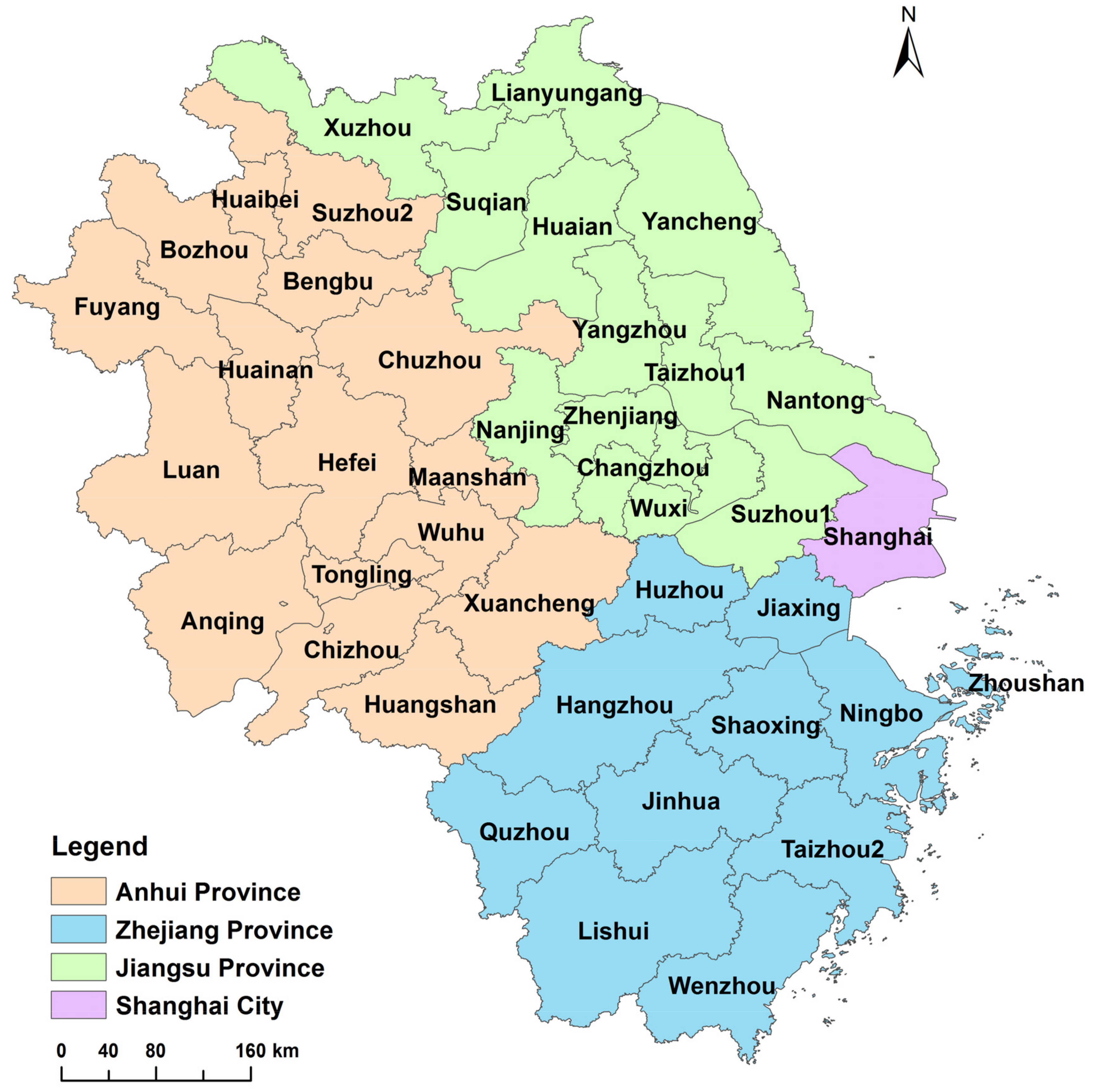
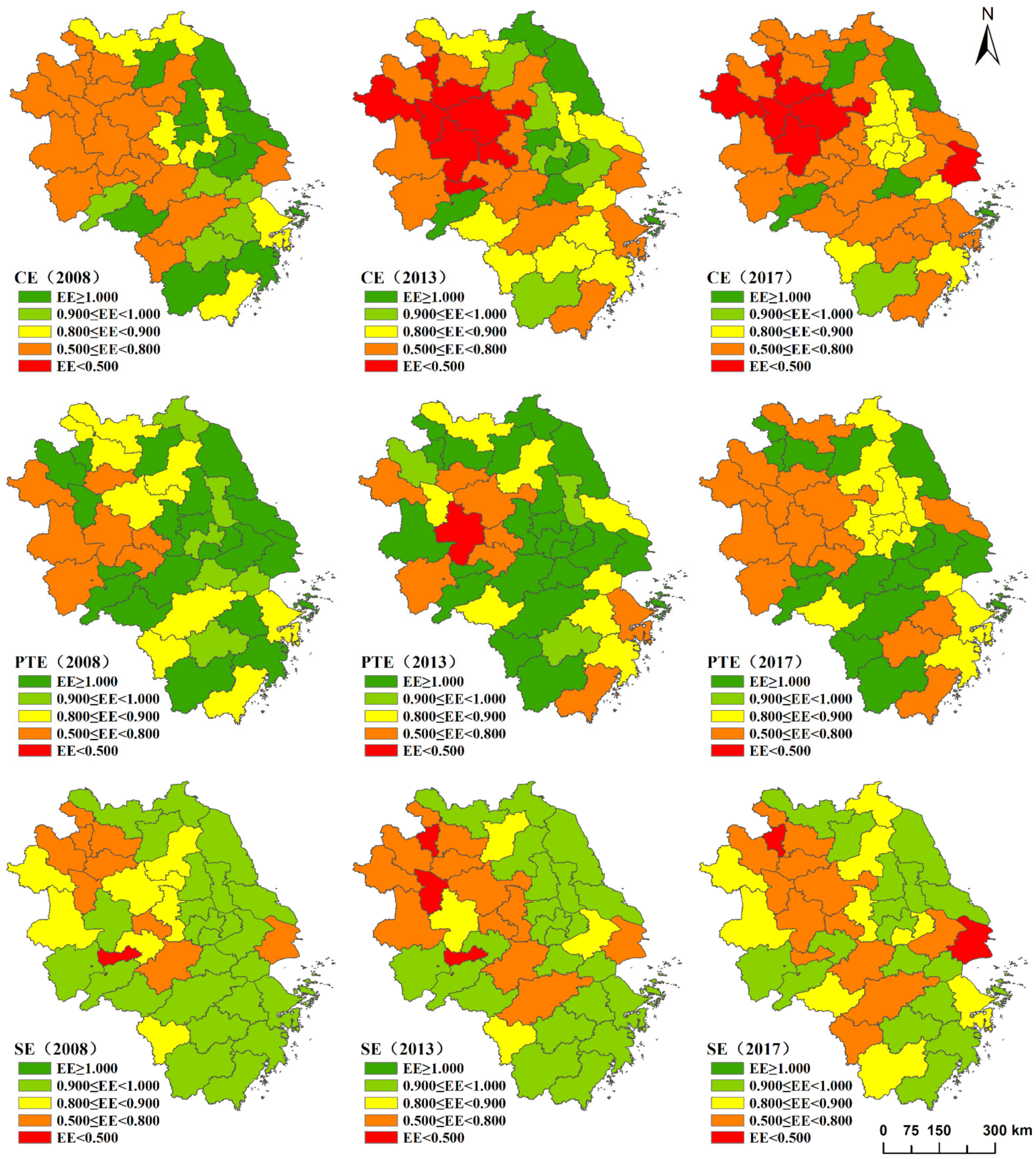
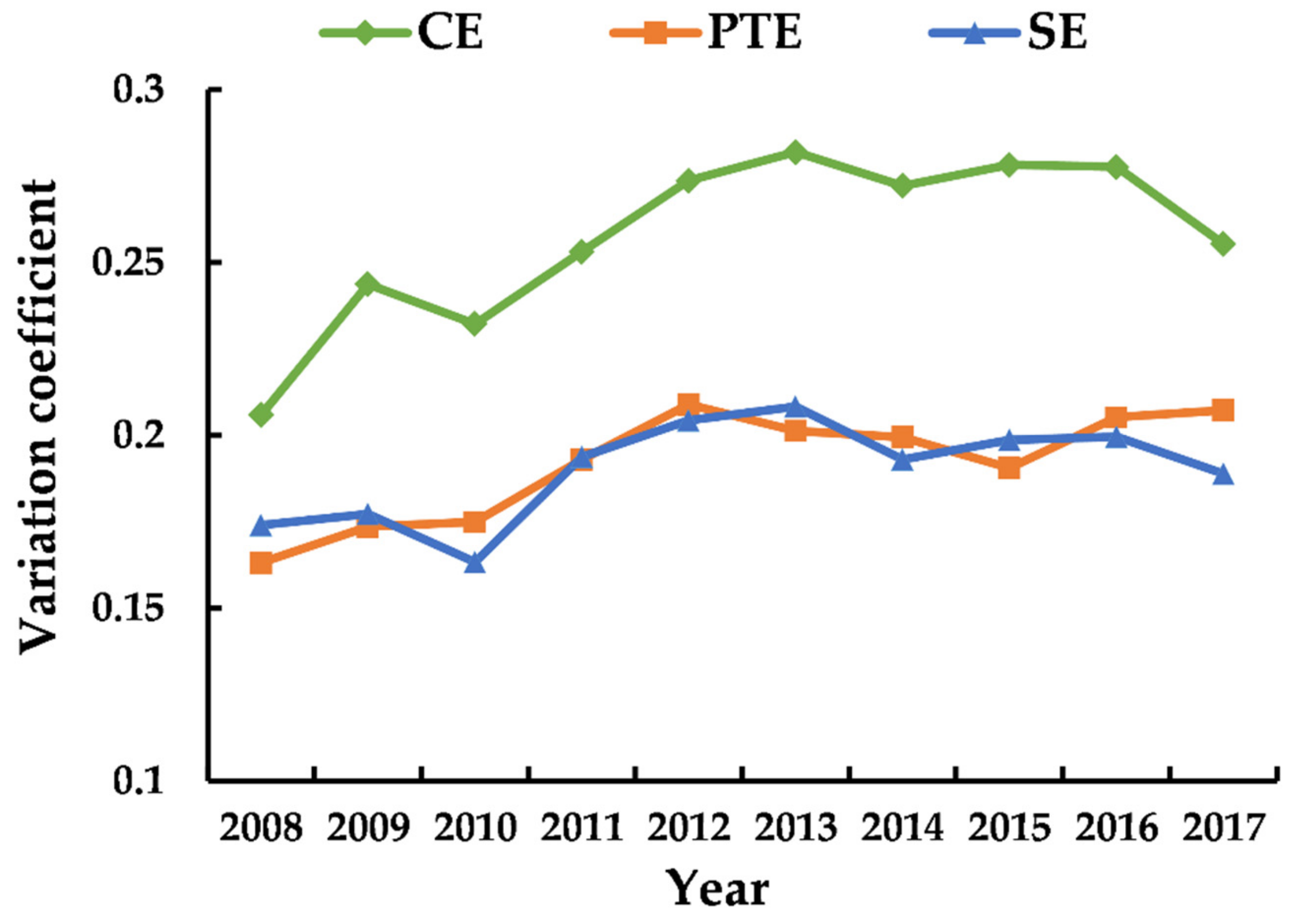
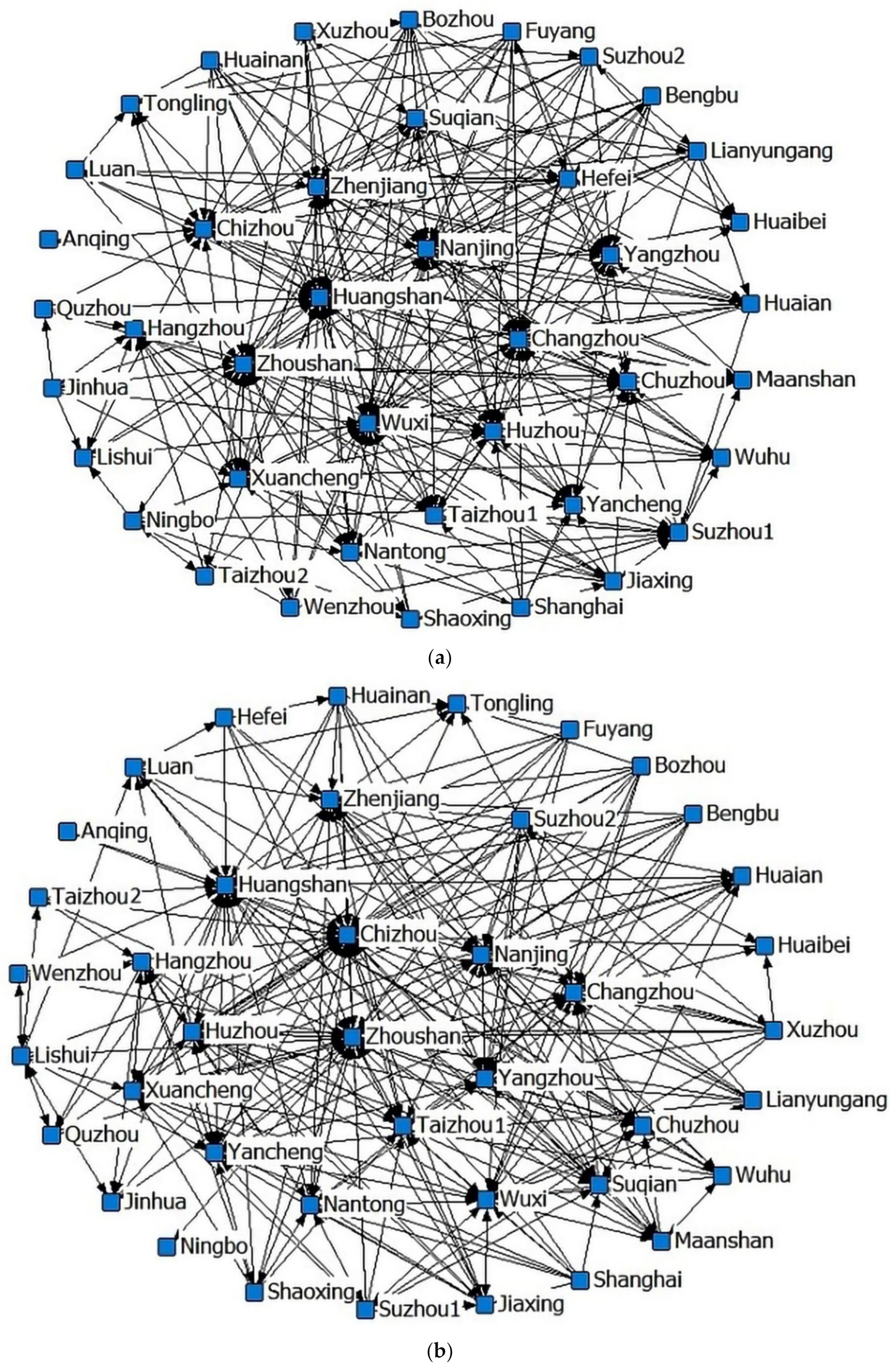
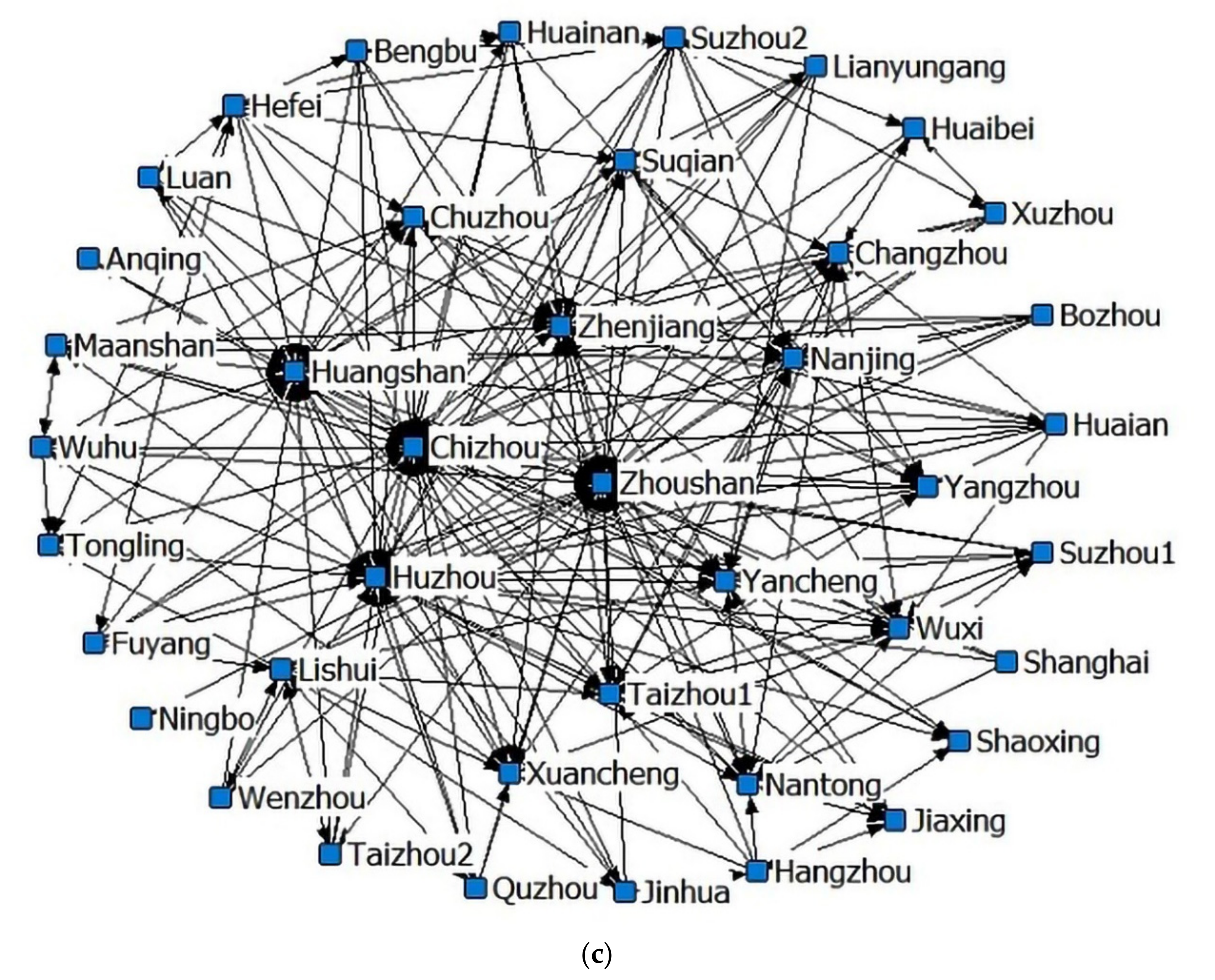
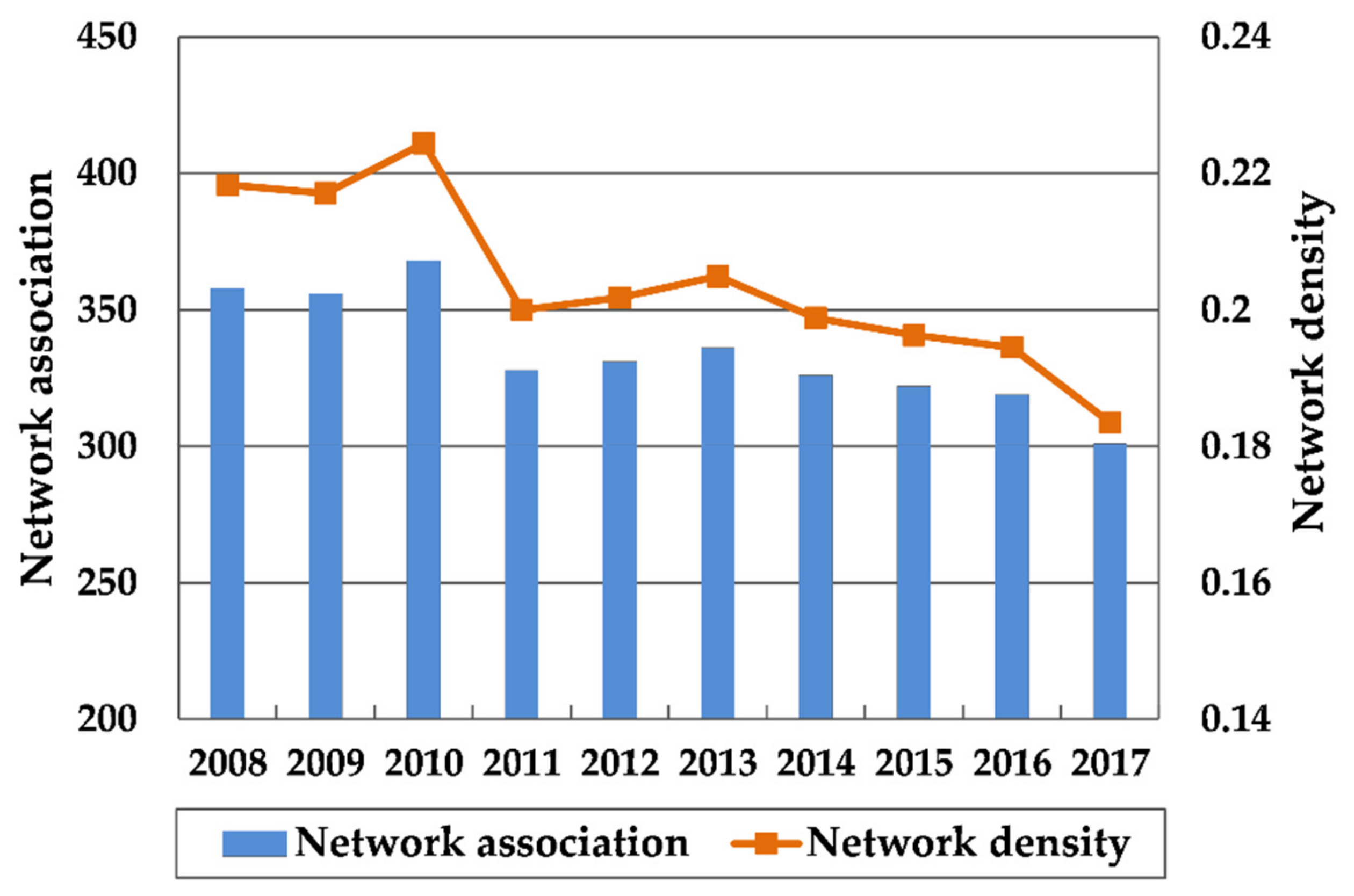
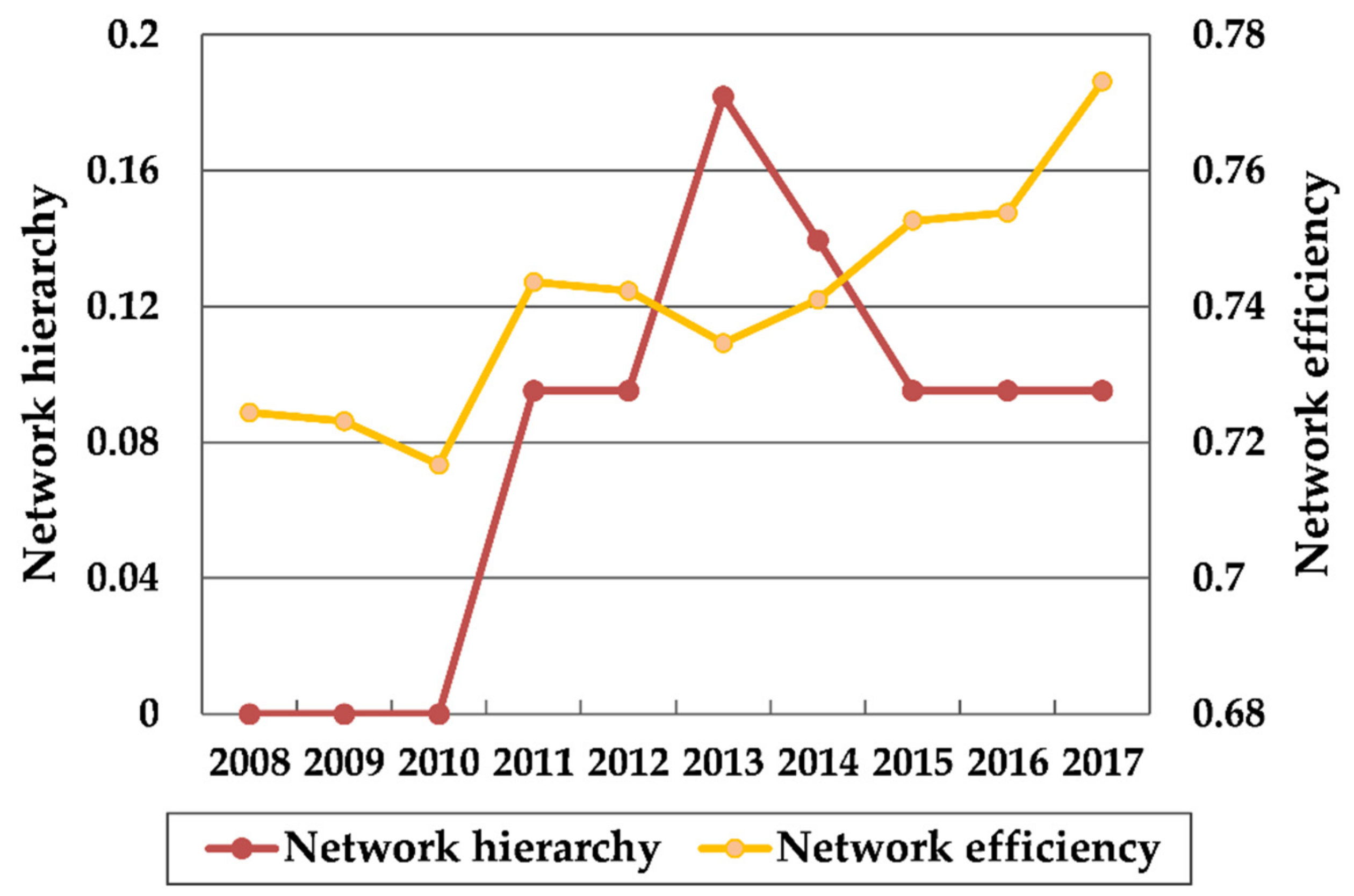
| Indicator Type | Indicator Name | Primary |
|---|---|---|
| Input indicators | Labor input Capital input Energy input | Number of employees in the tertiary industry Fixed asset investment in the tertiary industry Tourism energy consumption |
| Desirable output indicator | Total tourism economy | Total tourism revenue |
| Undesirable output indicators | Tourism environmental pollution | Tourism CO2 emission Tourism wastewater discharge Tourism solid waste discharge |
| Province | 2008 | 2009 | 2010 | 2011 | 2012 | 2013 | 2014 | 2015 | 2016 | 2017 | Average |
|---|---|---|---|---|---|---|---|---|---|---|---|
| Jiangsu | 0.938 | 0.939 | 0.927 | 0.925 | 0.928 | 0.923 | 0.938 | 0.939 | 0.930 | 0.812 | 0.920 |
| Zhejiang | 0.905 | 0.867 | 0.871 | 0.830 | 0.861 | 0.865 | 0.851 | 0.847 | 0.839 | 0.828 | 0.857 |
| Shanghai | 0.623 | 0.563 | 0.658 | 0.602 | 0.676 | 0.636 | 0.590 | 0.525 | 0.514 | 0.486 | 0.587 |
| Anhui | 0.682 | 0.640 | 0.642 | 0.609 | 0.579 | 0.570 | 0.585 | 0.580 | 0.575 | 0.582 | 0.604 |
| Mean value | 0.787 | 0.752 | 0.775 | 0.742 | 0.761 | 0.749 | 0.741 | 0.722 | 0.715 | 0.677 | 0.742 |
| Explanatory Variables | Network Density | Network Efficiency | Network Hierarchy |
|---|---|---|---|
| Pearson correlation coefficient | 0.904 ** | −0.898 ** | −0.643 * |
| p-value | 0.000 | 0.000 | 0.045 |
| City | Degree Centrality | Betweenness Centrality | Closeness Centrality | City | Degree Centrality | Betweenness Centrality | Closeness Centrality | ||||
|---|---|---|---|---|---|---|---|---|---|---|---|
| In-Degree | Out-Degree | Centrality | In-Degree | Out-Degree | Centrality | ||||||
| Nanjing | 10 | 9 | 32.500 | 2.319 | 57.971 | Zhoushan | 37 | 9 | 92.500 | 16.830 | 93.023 |
| Wuxi | 8 | 9 | 27.500 | 0.661 | 57.143 | Taizhou2 | 2 | 5 | 12.500 | 1.124 | 53.333 |
| Xuzhou | 1 | 8 | 20.000 | 0.000 | 55.556 | Lishui | 6 | 9 | 27.500 | 1.272 | 57.143 |
| Changzhou | 8 | 8 | 25.000 | 2.738 | 57.143 | Shanghai | 0 | 4 | 10.000 | 0.000 | 56.338 |
| Suzhou1 | 3 | 7 | 17.500 | 0.079 | 54.795 | Hefei | 4 | 11 | 27.500 | 8.314 | 57.971 |
| Nantong | 9 | 9 | 27.500 | 3.182 | 57.971 | Wuhu | 4 | 8 | 20.000 | 0.176 | 55.556 |
| Lianyungang | 1 | 8 | 20.000 | 1.734 | 55.556 | Bengbu | 2 | 8 | 20.000 | 0.256 | 55.556 |
| Huaian | 2 | 9 | 22.500 | 0.329 | 56.338 | Huainan | 3 | 7 | 20.000 | 2.546 | 55.556 |
| Yancheng | 13 | 9 | 35.000 | 4.196 | 60.606 | Maanshan | 7 | 8 | 20.000 | 1.686 | 55.556 |
| Yangzhou | 8 | 7 | 27.500 | 0.248 | 57.971 | Huaibei | 3 | 3 | 12.500 | 0.064 | 53.333 |
| Zhenjiang | 17 | 10 | 45.000 | 5.315 | 62.500 | Tongling | 6 | 2 | 15.000 | 0.293 | 51.282 |
| Taizhou1 | 12 | 9 | 32.500 | 4.116 | 59.701 | Anqing | 2 | 2 | 5.000 | 0.107 | 47.059 |
| Suqian | 5 | 10 | 27.500 | 5.109 | 57.971 | Huangshan | 25 | 14 | 65.000 | 23.525 | 74.074 |
| Hangzhou | 3 | 7 | 20.000 | 0.307 | 54.054 | Fuyang | 1 | 7 | 17.500 | 0.138 | 54.795 |
| Ningbo | 1 | 1 | 2.500 | 0.075 | 48.780 | Suzhou2 | 4 | 10 | 30.000 | 3.392 | 58.824 |
| Wenzhou | 2 | 5 | 12.500 | 1.124 | 53.333 | Chuzhou | 9 | 9 | 27.500 | 1.641 | 57.971 |
| Jiaxing | 4 | 7 | 17.500 | 1.164 | 54.795 | Luan | 3 | 6 | 15.000 | 7.442 | 54.054 |
| Huzhou | 27 | 13 | 72.500 | 10.570 | 76.923 | Xuancheng | 11 | 6 | 27.500 | 2.715 | 57.971 |
| Shaoxing | 3 | 5 | 12.500 | 1.390 | 53.333 | Chizhou | 31 | 5 | 77.500 | 9.273 | 80.000 |
| Jinhua | 2 | 6 | 15.000 | 1.105 | 54.054 | Bozhou | 0 | 6 | 15.000 | 0.000 | 54.054 |
| Quzhou | 2 | 6 | 15.000 | 0.511 | 54.054 | Mean value | 7.341 | 7.341 | 26.463 | 3.099 | 58.146 |
| Block | Number of Cities | Reception | Spillover | Expected Internal Relationship Ratio (%) | Actual Internal Relationship Ratio (%) | Block Attributes | ||
|---|---|---|---|---|---|---|---|---|
| Internal | External | Internal | External | |||||
| Block 1 | 5 | 5 | 46 | 5 | 38 | 10.00 | 11.63 | two-way spillover block |
| Block 2 | 6 | 4 | 125 | 4 | 53 | 12.50 | 7.02 | net benefit block |
| Block 3 | 18 | 27 | 31 | 27 | 104 | 42.50 | 20.61 | net spillover block |
| Block 4 | 12 | 9 | 54 | 9 | 61 | 27.50 | 12.86 | agent block |
| Block | Density Matrix | Image Matrix | ||||||
|---|---|---|---|---|---|---|---|---|
| Block 1 | Block 2 | Block 3 | Block 4 | Block 1 | Block 2 | Block 3 | Block 4 | |
| Block 1 | 0.250 | 0.333 | 0.111 | 0.300 | 1 | 1 | 0 | 1 |
| Block 2 | 0.067 | 0.133 | 0.185 | 0.431 | 0 | 0 | 1 | 1 |
| Block 3 | 0.311 | 0.657 | 0.088 | 0.023 | 1 | 1 | 0 | 0 |
| Block 4 | 0.267 | 0.611 | 0.005 | 0.068 | 1 | 1 | 0 | 0 |
| Relationship between Blocks | Block 1 | Block 2 | Block 3 | Block 4 |
|---|---|---|---|---|
| Block 1 | 5 | 10 | 10 | 18 |
| Block 2 | 2 | 4 | 20 | 31 |
| Block 3 | 28 | 71 | 27 | 5 |
| Block 4 | 16 | 44 | 1 | 9 |
Publisher’s Note: MDPI stays neutral with regard to jurisdictional claims in published maps and institutional affiliations. |
© 2021 by the authors. Licensee MDPI, Basel, Switzerland. This article is an open access article distributed under the terms and conditions of the Creative Commons Attribution (CC BY) license (http://creativecommons.org/licenses/by/4.0/).
Share and Cite
Sun, Y.; Hou, G. Analysis on the Spatial-Temporal Evolution Characteristics and Spatial Network Structure of Tourism Eco-Efficiency in the Yangtze River Delta Urban Agglomeration. Int. J. Environ. Res. Public Health 2021, 18, 2577. https://doi.org/10.3390/ijerph18052577
Sun Y, Hou G. Analysis on the Spatial-Temporal Evolution Characteristics and Spatial Network Structure of Tourism Eco-Efficiency in the Yangtze River Delta Urban Agglomeration. International Journal of Environmental Research and Public Health. 2021; 18(5):2577. https://doi.org/10.3390/ijerph18052577
Chicago/Turabian StyleSun, Yiyang, and Guolin Hou. 2021. "Analysis on the Spatial-Temporal Evolution Characteristics and Spatial Network Structure of Tourism Eco-Efficiency in the Yangtze River Delta Urban Agglomeration" International Journal of Environmental Research and Public Health 18, no. 5: 2577. https://doi.org/10.3390/ijerph18052577
APA StyleSun, Y., & Hou, G. (2021). Analysis on the Spatial-Temporal Evolution Characteristics and Spatial Network Structure of Tourism Eco-Efficiency in the Yangtze River Delta Urban Agglomeration. International Journal of Environmental Research and Public Health, 18(5), 2577. https://doi.org/10.3390/ijerph18052577





